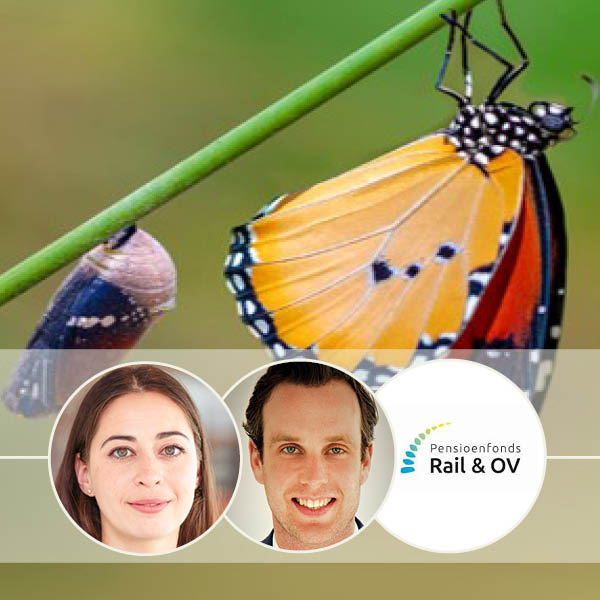Last year Pension Fund Rail & OV published a case study on biodiversity, exploring how institutional investors can include this topic in socially responsible investment (SRI) policies. We spoke with Joël Habets, investment strategist, and Simona Kramer, portfolio manager Socially Responsible Investing (SRI) at Pension Fund Rail & OV.
Why did you choose to focus on biodiversity specifically?
When we updated our SRI policy in 2021, we realized it was important to set priorities, as it appeared impossible to focus on all SRI topics at once. Our first priority in this respect became the integration of the selected Sustainable Development Goals. In addition to that Rail & OV decided to take at least one topic every year to explore in much detail. In 2021 this was Climate change, resulting in our Climate policy. In 2022 Rail & OV selected biodiversity. We chose biodiversity because we saw the topic becoming increasingly important and expect it to be a topic that could potentially dominate the field of SRI for decades to come.
We soon realized biodiversity is like a many-headed monster and we were not sure what would be a good start in the first instance. Therefore, we looked for a partner who had experience with the topic and could help us explore the topic. Therefore we collaborated with WWF NL, which was especially useful in this first exploration phase. We had questions about where our focus and contribution should be, and WNF was extremely helpful as a knowledge and discussion partner.
What is the added value of this exploration for the pension fund?
It is a good basis for our next steps: developing policy and implementing a biodiversity strategy in our investment portfolio. By developing this report, we have built up knowledge and raised awareness of the relevance of the topic. The case study appeared a very useful way to start discussions with external managers or with peers within the sector as now we had something tangible to refer to and to share.
To compare climate and biodiversity and where we stand: On the topic of climate change, discussions on whether or not it is important aren’t needed anymore. We have clear commitments and concrete expectations of asset and portfolio managers in terms of climate and especially Paris alignment. For biodiversity we aren’t at that point yet, but the discussions we have and the knowledge we developed in constructing the case study, help us in our search for defining similar clear commitments and concrete expectations for biodiversity,
What are the next steps?
Last year served as a kickstart, and now we move on to the next phase of developing a policy plan. We see that a lot of lessons learned from developing our climate policy help us in formulating our next steps when it comes to a policy plan for biodiversity. And we also see this quicker uptake of biodiversity at other pension funds, data providers, engagement providers and asset managers. This saves time because we don’t have to start from scratch, even though biodiversity remains a far more complex topic than climate change.
One example of the developments we see in the market are collective initiatives, which are also part of our next steps. We are also looking at ways we can integrate biodiversity into our responsible investment instruments, such as voting, engagement and/or setting criteria for selection.
What is your approach to active ownership?
On an annual basis, we update our voting policy. We pay attention to whether a company has a biodiversity policy and whether biodiversity is a material topic. We hope that we can integrate biodiversity more in our voting policy and discuss this with our proxy advisor. Again, we see quick developments when it comes to action on biodiversity. We see changes now that didn’t seem possible a few months ago.
Another part of active ownership is engagement. Knowing the companies we invest in is part of our responsibility as an asset owner. We engage on several topics, but Paris alignment engagements are an essential block of our engagement strategy. We are looking into ways how we can broaden engagements on climate with biodiversity. In our case study, it became clear for which sectors biodiversity is a material topic and we will look at ways to use this information for setting the priorities of our engagement policy.
Does this also mean that biodiversity is part of your selection criteria?
We have made a start of integrating biodiversity into our investment decisions by making it part of our investment cases. This means that we take the topic of biodiversity into account when it comes to the decisions about whether or not an investment category is a good fit for Rail & OV, how the investments in the specific category should be constructed and what we expect from our managers who manage the assets in those categories.
However, this does not mean that we are already able to make use of clear measures of when an asset category meets our ‘Biodiversity standards’ or that we can rate when something has a positive impact on biodiversity. We don’t have these criteria yet, as these are all topics we have to explore further. However, integrating biodiversity as a topic in our investment cases is a useful starting point for us. It helps us explore these topics further and hopefully be better able in the future to get to the point where we can formulate these clear goals and objectives.
What did you learn that you want to pass on to other investors?
Don’t be put off by the fact that biodiversity is a complex theme because it will remain so if you keep waiting. Just start and learn while doing, for instance by including biodiversity in your investment policy and ask questions to your managers about what they do on biodiversity. Finally, it can be useful to get involved in one of the many initiatives and reach out to knowledge partners to help you.

